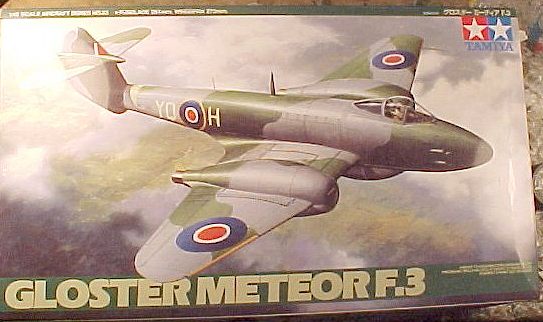
Tamiya 1/48 Meteor F.3
|
KIT # |
61083 |
|
PRICE: |
$34.95 |
|
DECALS: |
See review |
|
REVIEWER: |
|
|
NOTES: |

|
HISTORY |
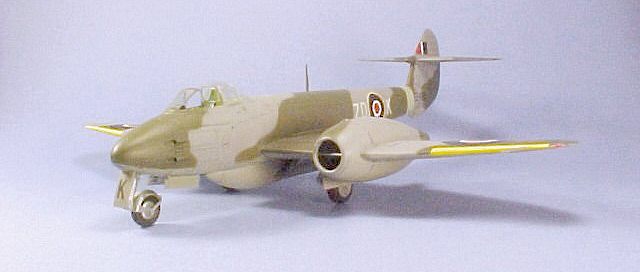
The Gloster Meteor began development in 1941, following the successful flight of the Gloster "Pioneer", powered by the Whittle jet engine. While Whittle's company, Power Jets, was allowed to develop what became known as the "Welland," which powered the Meteor prototypes, the F.1 and the first 15 F.3s, full-scale development of the jet engine was entrusted to Rolls-Royce; their version of the Whittle engine was known as the "Derwent."
The F.1, which first
equipped 616 "South Yorkshire" Squadron in the summer of 1944, may have been
revolutionary in terms of its powerplant, but in terms of overall performance -
with a top speed of only about 410 mph - it was not as fast as the Spitfire
XIV. The Meteor went in operations in August 1944, intercepting the V-1s the
Germans were launching against London, and achieved some success in this role.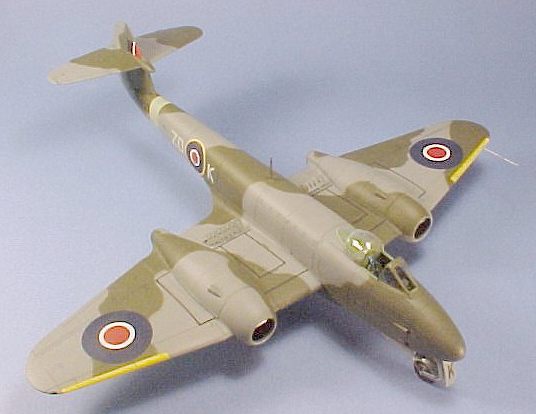
The F.3 appeared in the fall of 1944. Due to development delays with the Derwent, the first 15 were powered by the Power Jets Welland. From the 16th aircraft on, the F.3 was powered by the Derwent 1, which provided some 500 pounds of thrust more than the Welland, and gave the F.3 a top speed of approximately 475 mph. This was still well below the 540 mph top speed of the Messerschmitt Me-262, which was also just entering squadron service at this time. 207 F.3s were ultimately produced by the time the production line changed over to the F.4 in the fall of 1945.
In addition to 616 Squadron, the F.3 was flown operationally during the war by 504 Squadron, which followed 616 with a detachment operating in Holland in April 1945. By the summer after V-E day, the Meteor equipped two wings: 56, 74 and 245 Squadrons at Bentwaters, and 222, 234 and 263 Squadrons at Boxted. Ultimately, it would equip 18 squadrons during the course of its service.
In September 1945, two F.3s, EE454 and EE455 were modified with the extended engine nacelles developed for the F.4 - it had been determined that the early short engine cowling was the limiting factor in the Meteor's top speed due to drag rise over the nacelle. EE454, named "Britannia," retained its RAF camouflage; EE455 was painted bright yellow and named "Forever Amber." On November 7, 1945, Group Captain Wilson set a world's air speed record of 606 mph in EE454.
In 1948, two other F.3s, EE337 and EE387, were stripped of all unnecessary equipment and an "A" frame arrester hook was fitted, along with a new, strengthened undercarriage. After a first landing aboard HMS "Illustrious" by Captain Eric Brown in EE337, the two Meteors were successfully flown onto HMS "Implacable" 32 times between April and June, 1948, thus becoming the first British jet to operate from an aircraft carrier and only the second all-turbine aircraft to do so after the McDonnell FH-1 Phantom.
|
THE KIT |
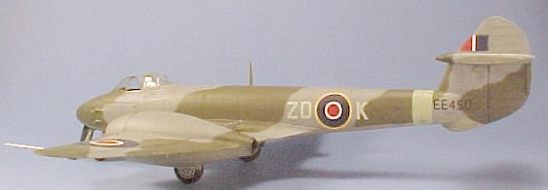 Tamiya released a "Meteor
I" in 1997 that immediately raised howls of protest, due to the fact that it was
not an F.1 - having been modeled after the Cosford Meteor, which combined an F.1
fuselage with an F.3 wing. Commendably, Tamiya went back and got the wing
right, and re-released it. Modelers have been waiting ever since for Tamiya to
take the F.3 wing they made and release a Meteor F.3. This was accomplished this
past May.
Tamiya released a "Meteor
I" in 1997 that immediately raised howls of protest, due to the fact that it was
not an F.1 - having been modeled after the Cosford Meteor, which combined an F.1
fuselage with an F.3 wing. Commendably, Tamiya went back and got the wing
right, and re-released it. Modelers have been waiting ever since for Tamiya to
take the F.3 wing they made and release a Meteor F.3. This was accomplished this
past May.
As Tamiya has released the kit, it makes up into one of the first 15 Meteor F.3s, powered by the Welland. However, parts F-10 and F-11 on the engine sprues provide shorter exhaust and the oil cooler vent - which are the two visual identifiers for the late production F.3. Thus, a modeler can make the "standard" F.3 if they so desire. Those modelers who want to make one of the three (the fourth being an F.1) "white Meteors" that were the first Meteors used operationally on the Continent in February 1945, will be able to do so by following the kit instructions to build the Welland-powered version.
|
CONSTRUCTION |
Construction of the model is straightforward and presents no difficulties. Tamiya provides a weight to insert immediately behind the cockpit. This is "just enough" weight to make the model a nose-sitter, though if it is placed on an uneven surface it can tail sit, as I had discovered with the F.1 - thus, I put a piece of lead weight in alongside that as "insurance." This makes the model a definite "nose sitter" under all circumstances.
 The Meteor is one Tamiya
kit that could really do with a nice resin cockpit from some aftermarket
supplier, since what is there is very basic. I put in some extra "clutter," and
equipped the seat with one of the new Eduard pre-painted seat belt sets for the
late-war "Q" seatbelts. I have to say that the Eduard set is very nice - the
pre-painted seatbelts look good, the paint does not scrape off, and they're the
right color. Any modeler who is a "klutz" when it comes to painting details
like seat belts will love these and I highly recommend them as being worth the
extra price.
The Meteor is one Tamiya
kit that could really do with a nice resin cockpit from some aftermarket
supplier, since what is there is very basic. I put in some extra "clutter," and
equipped the seat with one of the new Eduard pre-painted seat belt sets for the
late-war "Q" seatbelts. I have to say that the Eduard set is very nice - the
pre-painted seatbelts look good, the paint does not scrape off, and they're the
right color. Any modeler who is a "klutz" when it comes to painting details
like seat belts will love these and I highly recommend them as being worth the
extra price.
The kit came together over an evening's work, and was ready for the paint shop the next day.
|
PAINT & DECALS |
Painting:
I painted the model with
Gunze-Sanyo and Tamiya acrylics, using Gunze H-337 "Grayish Blue" for Ocean
Grey, H-73 "RAF Dark Green", and Tamiya XF-21 "Sky" and XF-20 "Medium Grey" for
Sea Grey Medium. Tamiya provides a good painting diagram, and with the paint
thinned 50-50 with rubbing alcohol and could tighten down the #1 fine tip of my
Paasche-H and freehand the scheme. For those of you who don't feel able to do
that, you can cut drafting tape to the pattern and mask off - run tape 1/16 inch
in from the edge to lift it, and you will get a "hard" edge with "scale"
overspray, and no "ridge" where the paint pooled against tape laid directly on
the surface. Once this was done, I Futured the model preparatory to applying
decals.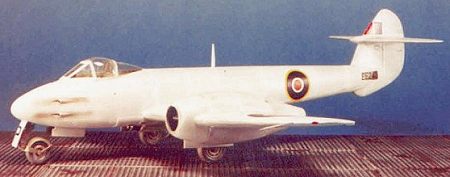
For those who want to do a "white" Meteor F.3, I am including a photograph of my other F.3 model - done from an early Tamiya F.1 kit with the "wrong" wing, and the Squadron (Falcon) vacuform canopy for the F.3. Basically, paint the model as described above, then apply a thinned coat of flat white over it like a German winter camo scheme; do it thin enough to "see through" to the original camouflage, and as you can see it looks good.
Decals:
Since I had already done a 616 Squadron airplane, I decided to do an F.3 from 222 Squadron of the second Meteor wing. I used the kit decals for the national markings - applied with a good coat of Micro-Sol followed by "heavy artillery" in the form of Solvaset to melt these thick decals onto the model. The serial number was cobbled together with the kit decal and other numbers out of the decal dungeon, and the underwing codes came from an old Modeldecal sheet, as did the squadron codes. Do remember, if you are going to do this, that the Meteor used squadron codes that were 20 inches high, rather than the standard 24-inch codes. When the decals had set, I washed off dried solvent, dried the model and applied Future.
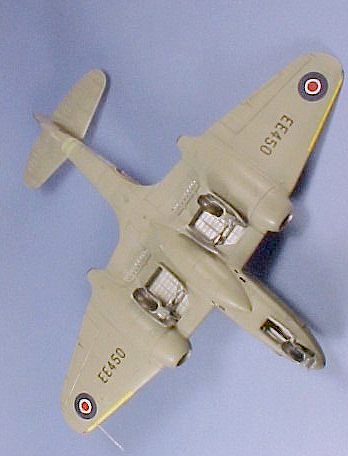 Final Finish:
Final Finish:
Photos of the Meteor in post-war service show that they were well-maintained and clean, without a lot of chipping. I applied several coats of thinned Dullcote to get the "slight sheen" flat finish I wanted. I then attached the landing gear and unmasked the canopy. Voila! The first major production version of the Meteor.
|
CONCLUSIONS |
As I said earlier, this is one kit that could do with a resin cockpit for better realism, though one can "busy up" what is there to an acceptable level. It looks nice next to my two earlier Meteors, and will look nicer next to the coming Classic Airframes Meteor F.8 and N.F.11.
July 2002
Copyright ModelingMadness.com. All rights reserved. No reproduction in part or in whole without express permission from the editor.
If you would like your product reviewed fairly and fairly quickly, please contact the editor or see other details in the Note to Contributors.
Back to Reviews Page 2024